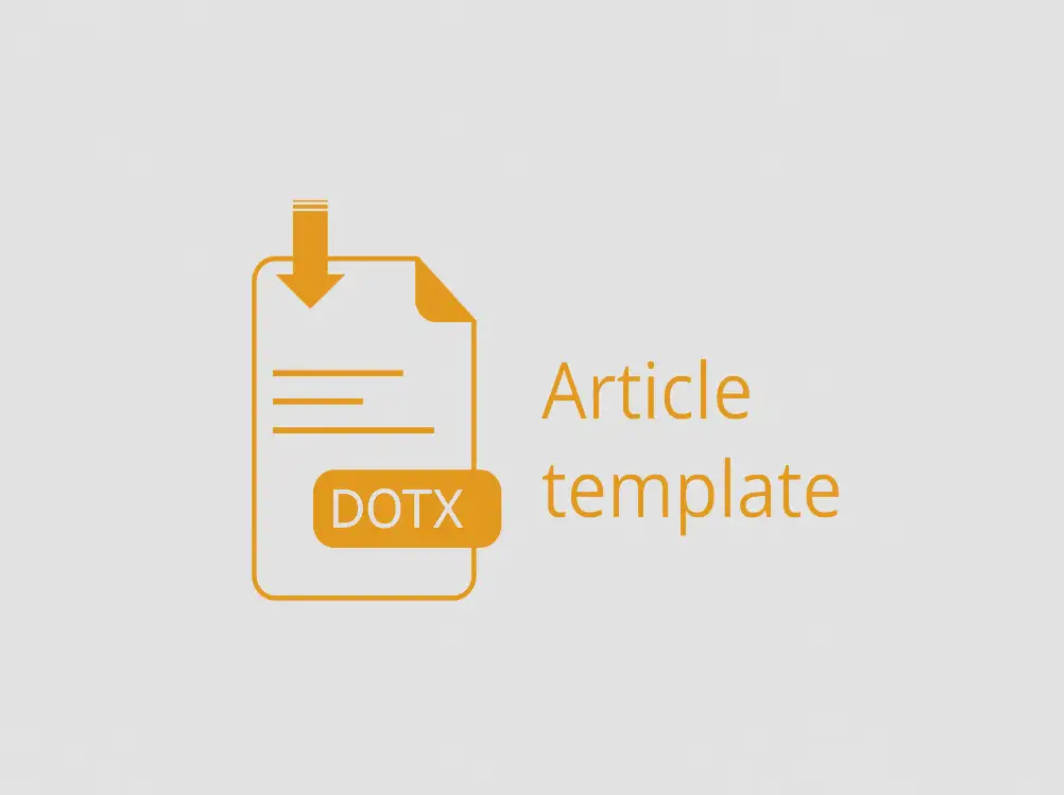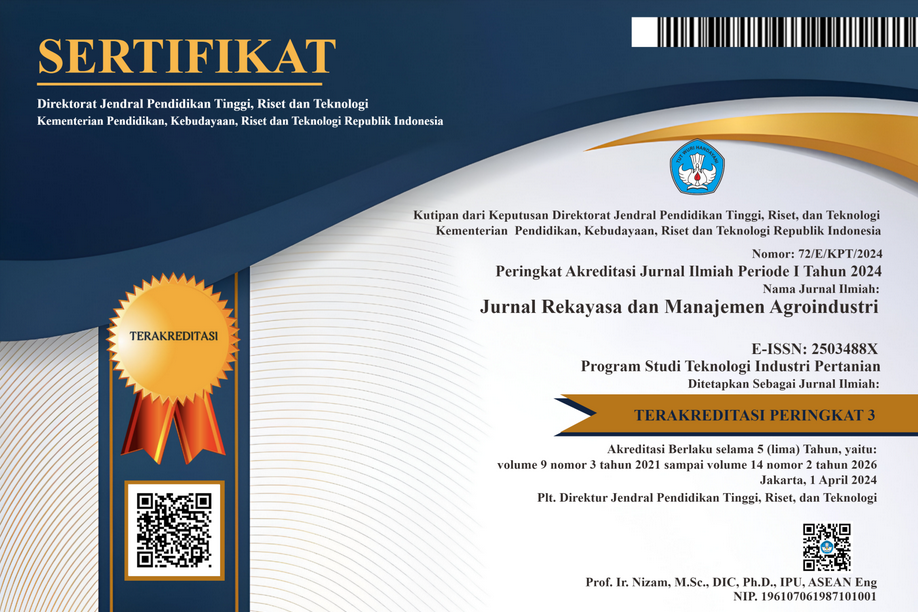Pengaruh Kecepatan Dan Lama Pengadukan Terhadap Karakteristik Mikroemulsi Minyak Atsiri Cengkeh (Syzygium aromaticum)
Abstract
The main product of the clove plant (Syzygium aromaticum) is essential oil. Clove oil has the advantage of being able to inhibit the growth of Staphylococcus aureus compared to other essential oils containing eugenol. The nature of essential oils is volatile so that in this study clove oil was made in the form of microemulsions because microemulsions are thermodynamically stable, transparent and have low viscosity. The characteristics of the microemulsion are influenced by several factors including the duration of stirring and the speed of stirring. The purpose of this study was to determine the effect of speed and duration of stirring on the characteristics of clove essential oil microemulsions and to determine the best speed and duration of stirring to produce the characteristics of clove essential oil microemulsions. This experiment used a randomized block design with two factors, namely speed and duration of stirring. Stirring was carried out for 4, 6 and 8 minutes and the stirring speed was 600, 700, 800 and 900 rpm. Data were analyzed for variance using excel, if there was an effect of treatment on the observed variables, the analysis was continued with the BNJ Test. The results showed that the combination of speed and duration of stirring had an effect on the characteristics of the resulting microemulsion. A speed of 600 rpm and a stirring time of 4 minutes was the best treatment for making clove essential oil microemulsions with the smallest turbidity index values after 24 hours of incubation and after centrifugation, namely 0.449 ± 0.026% and 0.473 ± 0.047%. Clove essential oil microemulsion particle size was 11.3 ± 2.5 nm. Clove essential oil microemulsion was stable for 8 weeks of storage.
Keywords : Microemulsion, essential oil, stirring speed, stirring time, Syzygium aromaticum.
Produk utama tanaman cengkeh (Syzygium aromaticum) ialah minyak atsiri. Minyak cengkeh memiliki keunggulan yaitu kemampuan menghambat pertumbuhan bakteri Staphylococcus aureus dibanding dengan minyak atsiri yang mengandung eugenol lainnya. Sifat dari minyak atsiri mudah menguap sehingga pada penelitian ini minyak cengkeh dibuat dalam bentuk mikroemulsi sebab mikroemulsi secara termodinamika bersifat stabil, transparan, dan viskositasnya rendah. Karakteristik mikroemulsi dipengaruhi oleh beberapa faktor diantaranya lama pengadukan dan kecepatan pengadukan. Adapun tujuan dari penelitian ini adalah mengetahui pengaruh kecepatan dan lama pengadukan terhadap karakteristik mikroemulsi minyak atsiri cengkeh dan menentukan kecepatan dan lama pengadukan terbaik untuk menghasilkan karakteristik mikroemulsi minyak atsiri cengkeh. Percobaan ini menggunakan Rancangan Acak Kelompok dengan dua faktor yaitu kecepatan dan lama pengadukan. Pengadukan dilakukan selama 4, 6 dan 8 menit dan kecepatan pengadukan 600, 700, 800, dan 900 rpm. Data dianalisis varian menggunakan excel, apabila ada pengaruh perlakuan terhadap variabel yang diamati, analisis dilanjutkan dengan Uji BNJ. Hasil penelitian menunjukkan bahwa kombinasi kecepatan dan lama pengadukan berpengaruh terhadap karakteristik mikroemulsi yang dihasilkan. Kecepatan 600 rpm dan waktu pengadukan selama 4 menit merupakan perlakuan terbaik untuk membuat mikroemulsi minyak atsiri cengkeh dengan nilai indeks turbiditas terkecil setelah inkubasi 24 jam dan sesudah sentrifugasi yaitu 0,449±0,026% dan 0,473±0,047%. Ukuran partikel mikroemulsi minyak atsiri cengkeh sebesar 11,3±2,5 nm. Mikroemulsi minyak atsiri cengkeh stabil selama penyimpanan 8 minggu Kata
kunci: Mikroemulsi, minyak atsiri, kecepatan pengadukan, lama pengadukan, Syzygium aromaticum.
Downloads
References
Bakan, J. A. 1995. Microemulsion. Di dalam Encyclopedia of Pharmaceutical Technology. Swarbrick, J., J. C. Boylan (Eds.). Marcel Dekker Inc, New York. p. 335-369.
Cho, Y. H., S, Kim., E, K. Bae., C, K. Mok., and J, Park. 2008. Formulation of a cosurfactant-free o/w microemulsion using nonionic surfactant mixtures. Journal of Food Science. 73(3):115-121.
Cui, J., Yu, B., Zhao, Y., Zhu, W., Li, H., Lou, H., and Zhai, G. 2009. Enhancement of oral absorption of curcumin by self-microemulsiyifing drug delivery systems. International Journal of Pharmaceutical. 371(1-2):148-155.
Di Scipio, S., D, Blanco., A, Diaz., A, Mireles., and A, Murillo. 2012. Influence of egg yolk/Tween60 surfactant blends on the behavior of o/w concentrated emulsions, Chemical Engineering Transactions. 24:577- 582.
Firyanto, R., P, Kusumo., dan I, E. Yuliasari. 2020. Pengambilan minyak atsiri dari tanaman sereh menggunakan metode ekstraksi soxhletasi. Journal of Chemical Engineering. 1(1):1-6.
Hadi, S. 2012. Pengambilan minyak atsiri bunga cengkeh (clove oil) menggunakan pelarut n-heksana dan benzena. Jurnal Bahan Alam Terbarukan. Semarang. 1(2):25-30.
Haryono, A., K, W. Restu., dan S, B. Harmami. 2012. Preparasi dan karakterisasi nanopartikel aluminium fosfat. Jurnal Sains Materi Indonesia. 14(1):51- 55.
Ketaren, S. 1985. Pengantar teknologi minyak atsiri. Balai Pustaka. Jakarta. 45-64.
Khan, B. A., N, Akhtar., H, Khan., and V, A. Braga. 2013. Development, characterization and antioxidant activity of polysorbate based O/W emulsion containing polyphenols derived from Hippophae rhamnoides and Cassia fistula. Brazilian jurnal of Pharmaceutical Sciences, 49(4):763-773.
Lestari, W. C. 2017. Efek antibakteri uap minyak atsiri bunga cengkeh (Syzygium aromaticum L.) terhadap pertumbuhan escherichia coli dan staphylococcus aureus dengan metode gaseous contact. Skripsi. Tidak Dipublikasikan. Program Studi Farmasi, Fakultas Matematika dan Ilmu Pengetahuan Alam, Universitas Islam Indonesia.
McClements, D. J., and E, A. Decker. 2000. Lipid oxidation in oil-inwater emultions: impact of molecular environment on chemical reaction in heterogeneous food system. Journal of Food Science. 65(8):1270-1282.
McClements, D. J., dan J, Rao. 2011. Food-grade nanoemulsions: formulation, fabrication, properties, performance, biological fate, and potential toxicity. Critical Reviews in Food Science and Nutrition. 51(4):285- 330.
Minasari. 2017. Effect of essential olis of clove and cumin against the growth of staphylococus. Padjadjaran Journal of Dentistry. 28(1):7-12.
Nidhin, M., K, J. Sreeram., R, Indumathy dan B, U. Nair. 2008. Syntesis of iron oxide nanoparticles of narrow size distribution on polysaccharide templates. Bulletin of Materials Science. 31(1):93-96.
Novianty, T. 2008. Pengaruh formulasi sediaan losio terhadap efektfitas minyak buah merah tabir surya dibandingkan terhadapa sediaan tabir surya yang mengandung oktinoksat. Skripsi. Tidak Dipublikasikan. Sarjana. Universitas Indonesia.
Permana, I. D. G. M., dan L, Suhendra. 2015. Optimasi konsentrasi VCO dalam mikroemulsi m/a dengan tiga surfaktan sebagai pembawa senyawa bioaktif. Media Ilmiah Teknologi Pangan (Scientific Journal of Food Technology). 2(2):106-114.
Pratiwi, A., dan Utami, B. L. 2018. Isolasi dan analisis kandungan minyak atsiri pada kembang leson. Jurnal bioeksperimen. 4(1):42-47.
Purwatiningrum, H. 2014. Formulasi dan uji sifat fisik emulsi minyak jarak (Oleum ricini) dengan perbedaan emulgator derivat selulosa. Jurnal Ilmiah Farmasi. 3(1):1-4.
Sari, D. K., dan N, Sauqi. 2018. Pengaruh demulsifier a dan demulsifier b terhadap craude oil bantayan dengan metode bottle test demulsifier. Jurnal Teknik Patra Akademika. 9(1):23-31.
Sari, D. K., dan R, S. D. Lestari. 2015. Pengaruh waktu dan kecepatan pengadukan terhadap emulsi minyak biji matahari (Helianthus annuus L.) dan Air. 5(3):155-159.
Shafiq, S., F, Shakeel., S, Talegaonkar., F, J. Ahmad., R, K. Khar., and M, Ali. 2007. Design and development of oral oil in water ramipril nanoemulsion formulation: in vitro and in vivo evaluation. J Biomed Nanotech. 3(1):28-44.
Shafiq, S., Shakeel, F., Talegaonkar, S., Ahmad, F. J., Khar, R. K dan Ali, M. 2007. Development and bioavailability assessment of ramipril nanoemulsion formulation. Eur J Pharm Biopharm. 66(2):227-243.
Suhendra, L., S, Raharjo., P, Hastuti., dan C, Hidayat. 2012. Formulasi dan stabilitas mikroemulsi o/w sebagai pembawa fucoxanthin. Agritech. 32(3):230-239.
Suhendra, L., S, Raharjo., P, Hastuti., dan C, Hidayat. 2013. Efektivitas mikroemulsi o/w dengan surfaktan non ionik dalam menghambat fotooksidasi vitamin c pada model minuman. Agritech. 33(1):24-31.
Suhendra, L., S, Raharjo., P, Hastuti., dan C, Hidayat. 2014. Stabilitas mikroemulsi fucoxanthin dan efektifitasnya dalam menghambat foto oksidasi vitamin c pada model minuman. Agritech. 34(2):138-145.
Supriyo, E. 2007. Pengaruh konsentrasi surfactant pada formulasi propuxure 20 EC dan efektifitasny dalam membasmi aedes aegypti. Tesis. Master. Universitas Diponegoro.
Talegaonkar, S., A, Azeem., F, J. Ahmad., R, K. Khar., S, A. Pathan., and Z, I. Khan. 2008. Microemulsions: a novel approach to enhanced drug delivery. Recent Patents on Drug Delivery and Formulation. 2(2):238-257.
Zheng, C., M, Ting., Y, Wu., N, Kurtz., C, Orbe., P, Alexander., R, Seager., and M, Tedesco. 2022. Turbulent heat flux, downward longwave radiation and large- scale atmospheric circulation associated with the wintertime Barents-Kara Sea extreme sea ice loss events. Journal of Climate. 35(12):3747-3765.

Ciptaan disebarluaskan di bawah Lisensi Creative Commons Atribusi-BerbagiSerupa 4.0 Internasional.
Seluruh artikel di Jurnal ini dapat disebarluaskan atas tetap mencantumkan sumber yang syah. Identitas judul artikel tidak boleh dihilangkan. Penerbit tidak bertangggung jawab terhadap naskah yang dipublikasikan. Isi artikel menjadi tanggung jawab Penulis.














